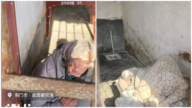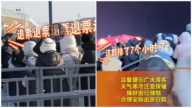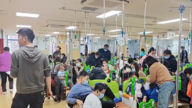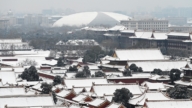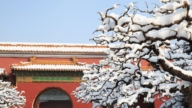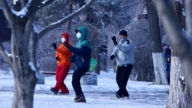【新唐人2013年11月01日訊】備受海外媒體關注,並震驚中南海的「北京天安門汽車爆炸」事件,雖然因疑點重重而遭到各方質疑,但仍被當局定性為「暴力恐怖襲擊事件」。自中共執政以來,天安門前抗議、流血事件頻發,無論大小,最終都躲不過「暴亂」、「反動」的罪名。雖然天安門前的維穩手段不斷升級,但湧向天安門廣場的抗議者卻越來越多,抗議的方式也越加激烈,使得當局每年數千億維穩經費的投入,成了赤裸裸的諷刺。
10月30號,北京警方就28號發生的天安門汽車爆炸事件,公布調查結果。警方說:「10•28」事件是一起由維族人「經過嚴密策劃,有組織、有預謀的暴力恐怖襲擊案件」,5名「在逃涉案人員」已經全部被抓獲。
由於中共當局在爆炸發生的第一時間封鎖了現場,甚至扣押了現場的外媒記者,又在事發後嚴控傳媒和網路,命令網警查禁了一切相關消息,使得海外媒體雖然對於此案極為關注,但由於了解的信息有限而無法確認事件的真相。
「中國冤民大同盟」美國總部主持者葛麗芳:「為甚麼封鎖那麼嚴密,肯定裏面有對共產黨不利的信息了。因為共產黨現在這種殘忍,已經引起每個被所謂人民政府鎮壓的或者迫害的這些人民個個都痛恨。它生怕再有更大的事情發生,而且它又要召開三中全會了。」
但各大國際媒體普遍認為,北京天安門已經成為民眾表達訴求的重要場所,儘管中共投入了巨額維穩經費並採用了無所不用其極的維穩措施,但仍然無法保證天安門的安全。
不同於其他國家的標誌性建築,北京天安門自1949年中共建政以來,已經被賦予了「政治」色彩。從1989年的「6.4」學生運動,到1999年的「4.25」法輪功萬人和平請願,再到近十年來前仆後繼湧向天安門抗議的訪民,都無一例外的遭到了中共當局的血腥暴力鎮壓。天安門廣場也從此成為中共最為敏感的一根神經。
這裏不僅沒有供人休息的座椅、遮蔭的樹木或涼亭,甚至連一座公廁都沒有。取而代之的是遍地的便衣、隨時檢查過往車輛和行人的警察,以及隱蔽在各個角落的攝像頭,和四處豎起的柵欄…… 維穩已經成為了中共執政的重中之重。
葛麗芳:「它越是這樣維穩,就像一個皮球一樣,它越是這樣把它壓下去,越是彈的更厲害。肯定它一直這樣拖,不解決問題,任何維穩是沒有作用的,其實根本都是徒勞,而且浪費國家的資源。」
中國社科院2013年的《社會藍皮書》指出,近年來大陸群體事件,已經由每年的幾萬起發展到每年十多萬起。據北京「清華大學」學者孫立平估計,2010年中共的維穩支出金額為5490億元人民幣,「群眾抗議事件」卻超過18萬宗;另一項由中共財政部公布的財政預算顯示,2012年大陸「公共安全」支出達到了7000億以上。但訪民依然滾雪球般的增加。
前往北京天安門的訪民逐年遞增,高峰時,每天會有數百訪民在天安門附近被抓。民眾抗議的方式也越來越激烈,從拉橫幅、撒傳單、裸奔、放鞭炮、舉牌等,發展到自殘甚至自殺。例如,武漢、內蒙、北京訪民跳天安門城樓;湖南、陝西訪民自焚;山東、上海、東北訪民跳金水河自殺等。悲劇不斷在天安門上演,有外媒因此將天安門形容為「絕望者的舞臺」。
維權人士悲嘆,長期以來,面對訪民們走投無路的各種申冤訴求方式,中共卻在不斷「完善」著針對訪民們的維穩手段,每一次民眾抗議的升級,換來的是更加嚴厲的維穩打壓,而民眾提出的實際問題,卻從不在考慮之列,如此維「穩」,社會怎能穩定?
採訪編輯/張天宇 後製/周天
More Maintaining Stability In Tiananmen
Makes It Less Stable
Tiananmen deadly crash shocked the Zhongnanhai high-level,
officials.
Although many doubtful points were questioned by the public,
the regime still classified it as “a violent terrorist attack".
Since the Chinese Communist Party (CCP) ruled China,
protests and major incidents often happened at Tiananmen.
No matter large or small the regime always
labeled it as a “riot" or “reactionary force".
Although maintaining stability measures for Tiananmen
constantly escalated, the protesters are still increasing, and
the ways of protests are more fierce.
The regime spends vast sums on maintaining stability that
has become a stark irony.
On Oct. 30, Beijing police announced investigation results
for the incident that took place on Oct. 28.
The police said the incident was “a violent terrorist attack
carefully planned, organized and premeditated" by Uighurs.
Police arrested five suspects connected to the incident.
The incident spot was immediately blocked, several foreign
journalists were temporary arrested on the site.
The internet was strictly controlled; all related news censored.
Although foreign media were very concerned about the
incident, they lacked truthful information.
Ge Lifang, US-based spokeswoman of China Alliance for
Victims of Injustice: “Why is the information so censored?
It certainly is something bad for the Chinese Communist
Party (CCP).
Because the CCP is so cruel, it has aroused every one’s
anger, from those who have been suppressed and persecuted.
The CCP fears that greater incidents will happen,
yet the Third Plenary Session opens soon."
Global mainstream media generally believe that Tiananmen
has become an important site for peoples’ injustice to be heard.
Although the CCP has spent huge sums on maintaining stability,
implementing all means of safeguards, it still cannot guarantee
the safety of Tiananmen.
Different to other country landmarks, since the CCP ruled
China from 1949 Tiananmen is covered by political atmosphere.
The Tianamen Students Protest on June 4, 1989, to Falun Gong’s
peaceful protest on April 25, 1999,
Over the past decade, petitioners repeatedly protested in
Tiananmen, all of them were violently suppressed.
Tiananmen Square became the CCP’s most sensitive nerve.
Not only are there no seats, trees or pagodas for tourists to rest,
there are no public toilets.
Instead plainclothes police are everywhere checking people
and vehicles at any time.
CCTV cameras are installed everywhere, Fences were put up.
Maintaining stability has become a top priority of the regime.
Ge Lifang: “The CCP’s maintaining stability is like bouncing
a ball, the more pressing down on it, the higher it jumps.
The regime always postponed situations like this,
never trying to solve the problem.
Maintaining stability is useless, wasting China’s resources."
The 2013 Blue Book of Chinese Society issued by Chinese
Academy of Social Sciences says the mass protests in
Mainland China have increased from a few thousand to
hundreds of thousands each year.
Sun Liping, scholar of Tsinghua University says, the cost of
maintaining stability in 2012 was 549 billion yuan.
Mass protests exceeded 180,000.
Financial Ministry’s budgets shows, in 2012, 700 billion
yuan was spent on “public security".
However, petitioners’ numbers have snow balled.
Petitioners going to Beijing is increasing yearly. At peak
times, several hundred were arrested near Tiananmen daily.
The kinds of protests have become more and more intense.
From unfolding banners, scattered fliers, naked runs,
and setting off fireworks, to committing suicide.
For example, petitioners from Wuhan, Inner Mongolian and
Beijing jumped off Tiananmen building.
Petitioners from Hunan and Shanxi set themselves on fire.
Petitioners from Shandong, Shanghai and North-East jump
to the river committed suicide.
Tragedies are repeatedly happening at Tiananmen Square.
Now foreign media call Tiananmen a “desperate stage".
Activists say that for the long term, facing desperate
petitioners’ various ways of petitioning, the CCP constantly
“improves" methods of maintaining stability to deal with them.
Each intensified protest results in a worse suppression.
The real problems that petitioners raised
are not considered by the CCP.
Can society be stablised by maintaining “stability?"







